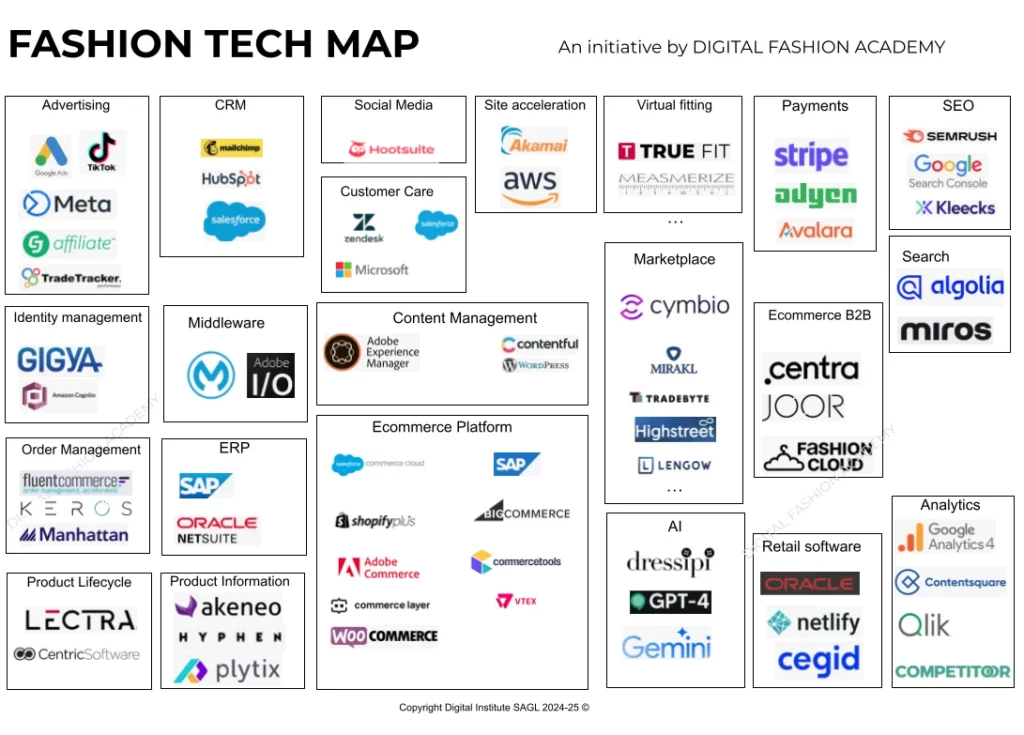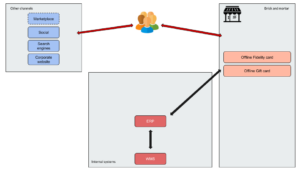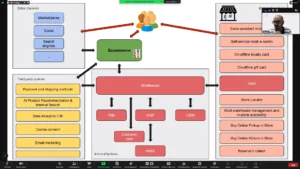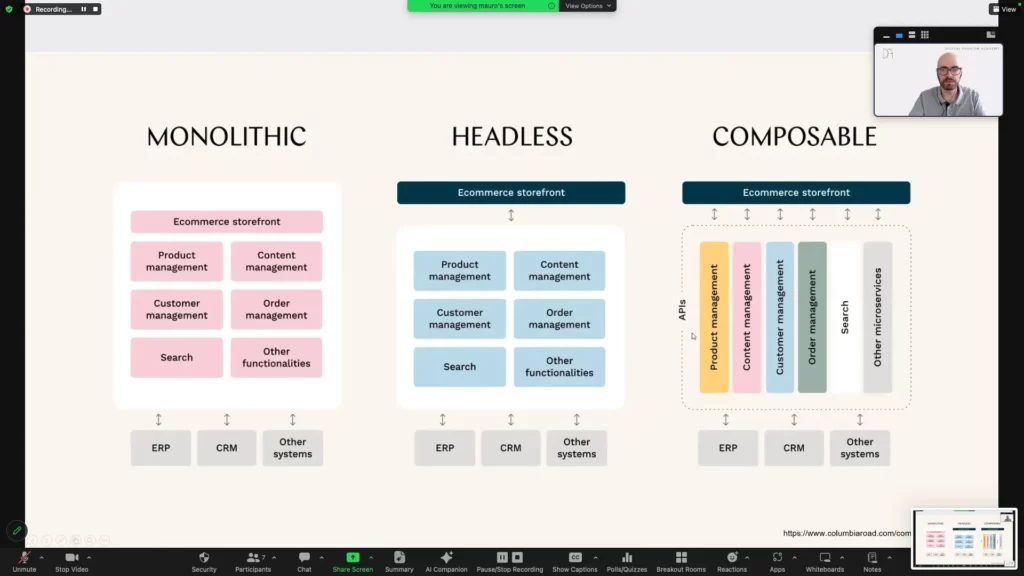Fashion Ecommerce is a technology driven business, which means that in order to succeed in fashion ecommerce you need to master and coordinate of technology solutions, to make them work together to satisfy your customer expectations.
The set of technologies that you need to link to each other or integrate, is usually called technology stack and this technology stack should suit the needs of your company and allow you to satisfy your customers’ expectations.
We discuss the Ecommerce Technology solutions in our course on Fashion Ecommerce Management and here below you have some insights from our course.
The starting point: the fashion ecommerce platform.
The starting point for launching a fashion ecommerce initiative is generally the selection of a fashion ecommerce platform. The selection of an ecommerce platform that will suit the needs of your company should start from the definition of the business requirrments. The process of selecting a platform should go through a competitive bidding process where you compare different platforms features and prices.
Ecommerce platforms, such as Adobe Commerce Cloud, Commerce Layer, Salesforce Commerce Cloud and Shopify meet different needs in terms of
- Costs
- Possibility of customisation
- Integration with other applications
- Ease of use
- Technical skills required
All fashion companies have a certain number of software applications that range from the basic office automation (Word Excel Powerpoint) to ERP (Enterprise Resource Planner) to complex ecommerce applications. The more digitally mature a company is the more applications they have, the process of increasing the number of application brings also the the mapping and design of processes. This change process goes under the definition of digital transformation.
In this article we start from the point of view of the fashion ecommerce technology to present an eco-system of applications that are most frequently adopted by fashion brands.
The map and the list of application has an illustrative and educational purpose, is based on the experience of the teachers and professionals who collaborate with the Digital Fashion Academy and doesn’t want to be comprehensive.
The purpose of this fashion tech map is to teach fashion professionals about the variety of applications that are necessary for running a successful fashion ecommerce and illustrate their purpose, their relation and why they are necessary.
This fashion tech map is a living document and was partly inspired by Scott Brinker’s Marketing Technology Landscape.

- The starting point: the fashion ecommerce platform.
- How is fashion technology evolving?
- When fashion brands grow: scaling up technology
- Fashion Ecommerce Technology solutions
- All-in-one and Multi-purpose platforms
- Fashion ecommerce platforms B2C
- Fashion Ecommerce Platforms B2B Wholesale
- Content Management Systems
- Front-end applications
- Marketplaces connector and enablers
- Feed generators
- Order Management System
- Analytics and Business Intelligence
- Advertising Platforms
- Identity Management
- Product Lifecycle Management (PLM)
- Product Information Management (PIM) and Digital Asset Management DAM
- Enterprise Resource Planning (ERP)
- Customer Relationship Management
- Middleware
- Social Media
- Customer Care
- Virtual fitting rooms
- Site search
- AI
- Payments
- Retail software
- Search Engine Optimisation (SEO)
- How is ecommerce technology evolving?
How is fashion technology evolving?
Although technology advances rapidly, certain fundamental aspects of fashion technology remain constant. Some applications have remained unchanged for decades, such as Enterprise Resource Planning (ERP), which is a crucial tool for fashion brands to perform essential functions.
The most important change is probably the migration towards ERP as a service rather than on premise. The “as a service” version of the ERP has the advantages of being accessible from anywhere and less technical maintenance needed.
The major changes we are seeing regard
- first party data and personal data treatment
- 3D Design
- Artificial Intelligence
- Buy fabrics and materials from suppliers
- Manage invoices and payment
- Manage clients
- Invoice clients
- Manage the financial situation
For a small fashion brand that only sells at wholesale level to a small number of B2B clients that’s all you need.
When fashion brands grow: scaling up technology
In a second stage of their life or even in the first for some D2C brands, it emerges the need for an ecommerce platform. The ecommerce platform is a software that allows to publish your products online and sell them directly to the customer via a check out page.
This particular area of fashion technology is undergoing significant change as the volumes and the importance of ecommerce for fashion brands profitability increases.
The importance of
- Website speed: core web vitals and conversion rate;
- New front-end features such as virtual fitting rooms, social media integration, reviews
- Need for more flexibility for large fashion brands: multiple languages, multiple currencies and so on
Pushed the fashion technology market to a specialization of the offer with new tech companies launching new software on the market that respond to a specific need of the fashion brads:
- Virtual Fitting Rooms
- Site speed accelerators
- Website SEO optimisation
- AI powered site search
- Customer reviews
- Live chat and chatbots
- Customer feedback collection
- Lead generation forms
- Personalization engines
How do we manage this complexity?
The standard way to manage this expansion is to add plug-in or extensions to our ecommerce platform, however adding several external resources to our platform could cause a degradation on the speed of the platform.
Ona tag to rule them all
If you work in digital marketing you may have experienced this situation when you had to integrate several tracking tags from different advertising platforms, e.g. Google Ads, Meta, Retargeting platforms, Affiliates. Then one day the Tag management solution was introduced: one tag to rule them all. So after you installed the tag manager solution on your platform, you could easily add additional tags without touching the code of your platform.
The fashion technology ecosystem
The fashion technology ecosystem varies from small medium enterprises (SMEs) to large corporations and its complexity increases with time as the company reaches a higher digital maturity.
Early stage map

Digitally mature stage

In the fashion technology lesson with Mauro Lorenzutti, specialising in ecommerce integrations @ Webformat, we have explored the main applications that fashion brands generally adopt in their technology stack.
The technological stack represented in the picture above is actually an advanced stage of integration for fashion companies, generally they start with just a few applications such as ERP and Ecommerce Platform.
When fashion brands or retailers approach ecommerce, they start small with just a few applications in their stack, but when the ecommerce business volume grows, companies need to add more features and as a consequence more applications.
The applications can be added on both front-end or back-end side:
Fashion Ecommerce Technology solutions
Ecommerce platforms generally allow companies to sell products online which means that they allow to present the users with web application or interface where the users can browse the products (the listing page), read the details of each product such as product description, colors available, sizes available and see the product pictures, and finally the users can add the products to cart and pay (check out).
The ecommerce platforms ability to manage stock data, product information (including price and images), orders, returns and payments, makes them a preferred solution for running an ecommerce business.
Fashion Ecommerce platforms constraints
However ecommerce platforms present several limitations when the ecommerce business is scaling up, for example, a brand may want to include more images for each product, for example because they need to use them on B2B channel, but the ecommerce platform only allows for uploading the images to be used in the product page.
In this example we show you the reason why in an ecommerce architecture (or ecommerce ecosystem) you may want to integrate a Product Information Management System (PIM) or a Digital Asset Management System (DAM)
Another constraint is that the ecommerce platform may not be suitable to manage multiple stock location in an efficient way, for example an ecommerce platform may not be able to decide whether a product should be shipped from the central warehouse or from a local store.
In this second example we illustrate one reason why fashion businesses decide to implement an Order Management System (OMS).
All-in-one and Multi-purpose platforms
Many software brands offer solutions that include a number of features already integrated with each other. An example is Salesforce which offers an Ecommerce Platform, Marketing Platform and CRM all integrated into one ecosystem.
Another example is SAP which integrates an ecommerce solution within its ERP. These multi-purpose platforms have their advantages, for example you can work with a single vendor for different purposes. However it doesn’t mean the complexity to manage the platform is less.
For the majority of these platforms brands we have indicated in our map and guide just the major features.
Fashion ecommerce platforms B2C
- Adobe Commerce Cloud (Magento)
- BigCommerce
- Commerce Layer (Composable)
- Commerce Tools (Composable)
- PrestaShop
- Salesforce Commerce Cloud
- SAP Commerce
- Shopify
- VTEX
Adobe Commerce (Magento) – A highly customizable and scalable eCommerce platform, ideal for fashion brands looking for flexibility. It offers AI-powered personalization, advanced merchandising, and seamless omnichannel experiences. Brands examples: Helly Hansen, Paul Smith, Christian Louboutin
BigCommerce – A SaaS-based eCommerce platform with strong B2C and B2B capabilities. It provides built-in SEO tools, flexible APIs, and excellent scalability, making it suitable for growing fashion brands. Martha Stewart, Ted Baker. Brands examples: Martha Stewart, Ted Baker
Commerce Layer (Composable) – A headless commerce platform designed for global brands. It enables seamless integration with existing systems, allowing fashion businesses to create personalized shopping experiences across multiple channels. Brioni, Viu, Lampoo, Rapha
Commerce Tools (Composable) – A cloud-native, API-first commerce platform offering high flexibility. It’s ideal for fashion brands looking to build custom eCommerce experiences with modern, modular architecture. Brands examples: Bang & Olufsen, Just Eat, Selfridges
PrestaShop – A free, open-source platform with a large marketplace of themes and modules. It’s a good choice for small to mid-sized fashion retailers looking for cost-effective eCommerce solutions. Brands examples: Kaporal, Le Slip Français
Salesforce Commerce Cloud – A powerful, AI-driven eCommerce platform used by many luxury and global fashion brands. It provides deep customer insights, personalized shopping experiences, and strong omnichannel capabilities. Brands examples: Lacoste, Puma, Ralph Lauren, Burberry
SAP Commerce – An enterprise-grade solution with robust B2B and B2C functionalities. It’s known for its scalability, powerful product management, and AI-driven personalization, making it ideal for large fashion businesses. Brands examples: Versace, Adidas, Hugo Boss
Shopify – A user-friendly and scalable eCommerce platform, widely used by fashion brands of all sizes. It offers a vast ecosystem of apps, built-in marketing tools, and excellent design flexibility. Brands examples: Gymshark, Alo Yoga, Kith
VTEX – A multi-tenant SaaS platform with native marketplace and omnichannel capabilities. It’s a strong choice for fashion brands looking for a unified commerce experience across digital and physical stores. Brands examples: Levi’s, Under Armour, Victoria’s Secret
Fashion Ecommerce Platforms B2B Wholesale
B2B E-commerce Platforms: A Brief Overview
- Centra
- Joor
- NuOrder
- Shopify
- Centra
- Centra is a B2B e-commerce platform designed to streamline the wholesale ordering process. It offers features such as product catalogs, order management, and inventory tracking. Centra is particularly well-suited for brands with large product catalogs and a need for efficient order fulfillment.
- Strengths:
- Robust product catalog management: Handles complex product hierarchies and variations.
- Streamlined ordering process: Reduces manual data entry and errors.
- Inventory management: Ensures accurate stock levels and availability.
- Joor
- Joor is a global B2B marketplace that connects brands with retailers. It provides a platform for brands to showcase their collections, manage orders, and track sales. Joor is particularly valuable for brands looking to expand their reach and connect with a wider network of retailers.
- Strengths:
- Global reach: Connects brands with retailers worldwide.
- Visual merchandising tools: Helps brands create engaging product presentations.
- Analytics and insights: Provides data on sales performance and customer behavior.
- NuOrder
- NuOrder is a B2B wholesale platform that offers features such as order management, inventory tracking, and sales analytics. NuOrder is known for its user-friendly interface and focus on mobile accessibility. It’s a good choice for brands looking for a modern and intuitive platform.
- Strengths:
- User-friendly interface: Easy to navigate and use, even for non-tech-savvy users.
- Mobile accessibility: Allows for on-the-go order management and sales.
- Analytics and reporting: Provides insights into sales performance and customer trends.
- Shopify
- While primarily known for its B2C e-commerce platform, Shopify also offers a B2B solution. Shopify’s B2B features include wholesale pricing, customer accounts, and order management. While not as specialized as other B2B platforms, Shopify can be a good option for brands that already use its platform for their B2C operations.
- Strengths:
- Integration with existing Shopify infrastructure: Reduces the need for multiple platforms.
- Wide range of features: Offers a variety of tools for B2B e-commerce.
- Large ecosystem of apps and themes: Provides customization options.
Content Management Systems
- Adobe Experience Cloud
- WordPress
- Contentful
Front-end applications
- Site accelerators: akamai
- SEO optimization: kleecks
Marketplaces connector and enablers
- Mirakl
- Tradebyte
- Channel Engine
- Neteven
- Channel advisor
Feed generators
- Highstreet
- Lengow
Order Management System
- Fluent (Aldo, Balmain Paris, Carrera eyewear)
- Keros Digital (Benetton, Twinset, Cisalfa Sport)
- Manhattan (Gucci)
Analytics and Business Intelligence
- Google Analytics
- Qlick
- Content Square
- Competitoor > Price monitoring – analysis
- Google trends, Google Ads > Market analysis
Advertising Platforms
- Google Ads
- Meta Business Suite
- CJ Connection Junnction > affiliate network
- Trade Tracker > Affiliation platform
Identity Management
- Gigya
- Amazon Cognito
Product Lifecycle Management (PLM)
- Lectra
- Centric Software
Product Information Management (PIM) and Digital Asset Management DAM
The PIM and the DAM systems are the single “source of truth” for the product data and brand images. They are repositories for product data such as descriptions, translations, ecommerce photos and lookbook photos. The PIM and the DAM may export the product data to external systems such as Marketplaces and Google Merchant Center.
- Akeneo
- Pimcore
- Hyphen
- Plytix
Enterprise Resource Planning (ERP)
- SAP
- Oracle Netsuite
- Stealth
- Microsoft Dynamics
Customer Relationship Management
- Salesforce Marketing Cloud
- Mailchimp
- Hubspot
- Microsoft Dynamics
Middleware
- Mulesoft
- Adobe I/O
Social Media
- Hootsuite
- Meta Business Suite
- TikTok
Customer Care
- Zendesk
- Microsoft
- Salesforce
Virtual fitting rooms
- Truefit
- Measmerize
Site search
- Algolia
- Miros
AI
- GPT-4
- Gemini
- Contents.com
Payments
- Stripe
- Adyen
- Avalara (Tax Calculation)
- Checkout.com
- Klarna (Buy Now Pay Later)
- Paypal
Retail software
- Oracle X-store
- Cegid
- Netlify
- Shopify POS
Search Engine Optimisation (SEO)
- Google Search Console
- Semrush
- Kleecks
How is ecommerce technology evolving?
